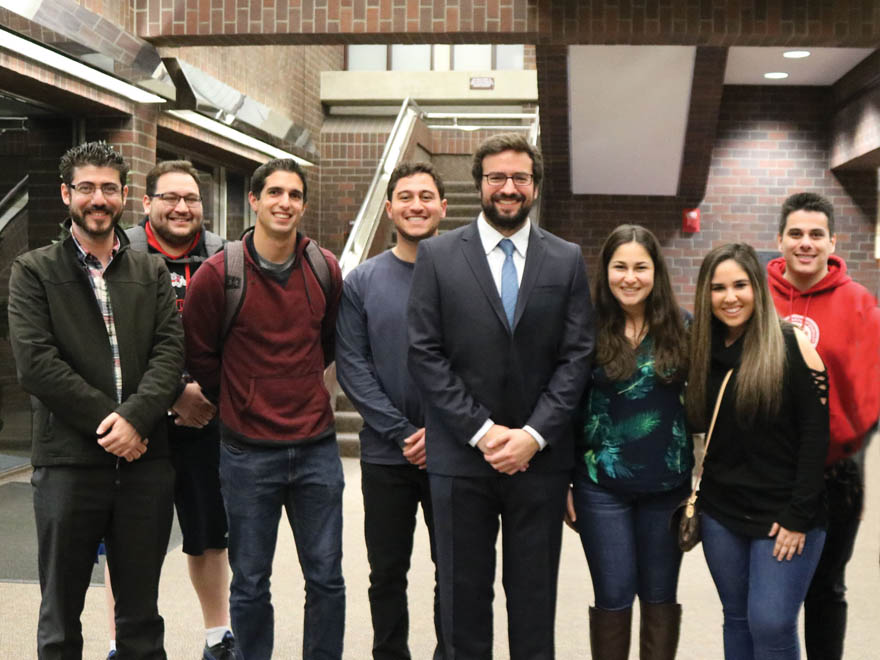
Sosse Baloian
Staff Writer
Fresno State’s Armenian Studies Program welcomed its 16th Henry Khanzadian Kazan Visiting Professor, Dr. Ari Şekeryan, to kick off his three-part lecture series with “An Untold Story of Survival: the Armenian Community in Istanbul During the Armistice Years (1918-1923),” on Tuesday, February 7, 2020. Dr. Şekeryan’s presentation enlightened the audience with insight on the political and social climate of this Ottoman Armenian community. Dr. Şekeryan sets himself apart from other Armenian historians by choosing to study a largely unexamined topic−how the Armenians in Istanbul preserved their identity under Ottoman rule.
Dr. Şekeryan is a graduate from universities in Turkey and England, where he received his PhD in the Department of Oriental Studies at the University of Oxford. Most recently he was a research fellow at the University of Wisconsin-Madison. Dr. Şekeryan is currently working on a book entitled, An Untold Story of Survival: The Armenians and the Fall of Ottomans, based on his dissertation about Armenians living in Istanbul and Anatolia after the Great War.
Dr. Şekeryan utilizes newspaper articles from collections of the Armenian and Ottoman Turkish press in Istanbul and Anatolia to interpret significant turning points in the political stance of this Ottoman Armenian community. His presentation highlighted documents that exemplified the transformation of the political position of the Armenian community during the Armistice years.
Dr. Şekeryan explained that in the beginning of 1918, “Ottomanism” was promoted as a tactic to unify all citizens in the Turkish Empire regardless of ethnicity or religion. He suggested that the Ottoman government used this unifying force in response to their major territorial losses from World War I. The government was trying to convince its Armenian and Greek communities not to seek independence. Not knowing that the fall of the Ottoman Empire was looming overhead, newspapers from the Armenian community in Istanbul welcomed the call for Ottoman brotherhood. Dr. Şekeryan provided an excerpt from an Armenian publication titled Vercheen Loor (“Latest News”), which encouraged Armenians to “enthusiastically shake the brotherly hand” of the Ottomans, effectively reinforcing this idea of unification.
However, Ottomanism was not able to save the Empire from its downfall. By the end of October 1918, after the Armistice of Mudros signaled the defeat of the Ottomans, the political stance of the Armenian community dramatically shifted from pro-Ottoman brotherhood to support for Armenian Independence. Armenians in the Diaspora and in the Ottoman Empire rallied around Woodrow Wilson’s “Fourteen Points,” which promoted the principle of self-determination of political minorities who were oppressed by pre-World War I empires.
As participants of the 1919 Paris Peace Conference, Ottoman Armenian and Armenian Republic representatives took the opportunity to attend the Conference and to announce the foundation of the Cabinet of United Armenia.
After witnessing the lack of aid from the Great Powers to atrocities occurring in the Armenian Republic and in Cilicia, the political stance of the Ottoman Armenian community once again shifted to protect their existence. They realized that the prospects for Armenia’s reestablishment after a Soviet takeover were very slight.
As Dr. Şekeryan argues, these Armenians lived in fortunate circumstances because they did not face deportation and were able to run businesses through the years after Armistice. In order to maintain peace in their community, they ceased all calls for independence.
The political realignment of these Ottoman Armenians brought forward the foundation of the Turkish-Armenian Ascent Association which aimed to reestablish the friendship between Armenia and Turkey.
Dr. Şekeryan provided a unique example from a speech by Harutiun Mosdijian, president of the association, during the 1923 Lausanne Conference. Mosdijian called for a mending of the relationship between the two nations. Mosdijian claimed that all Armenians wished for tensions to subside because the Turks were like their “big brothers.”
Dr. Şekeryan’s “Untold Story” left an impact on the audience because his examination provided an uncommon but noteworthy narrative of Armenian survival under Ottoman rule. He shared examples of how the Ottoman Armenians altered organizational tactics repeatedly as a way to adapt to the changing political climate, while still preserving and protecting their identity.
 Hye Sharzhoom Armenian Action
Hye Sharzhoom Armenian Action